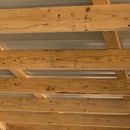Closed-Cell-Spray Foam in Shallow Rafter Cavities
Hello everyone,
This is my first post here. I have a cabin in Nogal, NM, zone 4B, 7,300 ft. elevation. It does get pretty cold and low 90s in the summer for a couple of weeks.
As part of a bedroom addition to the cabin, I would like to enclose a portion of the front porch for a small dining room.
My issue is that the porch metal ceiling is sitting on 2×6 rafters with strips (possibly 2x4s, can’t really tell from the picture) sandwiched between the rafters and ceiling metal. If the strips are 2x4s, then I would have around 7 inches of cavity between the rafters and the strips probably serve as thermal bridge breaks. The lower part of the ceiling sits right at 7’6″ and the highest part one foot higher. To cut costs, the interior finish will be drywall instead of T&G like the rest of the cabin.
The minimum insulations values for my zone, according to the contractor is R-38.
My thought was that I could reach it by going with close cell foam, but I am not sure what else I would need to do.
The contractor isn’t sure we would be able to meet code since the roof cavity is too shallow.
Is it possible to attain the minimum R value with the given cavity depth or would I need to add furring strips or similar? I also read about how hard it is to shave close cell foam to be able to install drywall. Not sure how much this comes into play.
Picture attached. Hopefully it came out clear.
I would appreciate your expert advice.
Thanks,
JP
GBA Detail Library
A collection of one thousand construction details organized by climate and house part










Replies
While it's a good goal to hit those insulation levels, have you confirmed with your local code enforcement officials that you need to meet that level on a renovation of this sort?
The contractor did hence why I am looking for options. Thanks.
For R-38 you'll need 6.5 inches of closed cell foam -- spray or polyiso board -- or 10 inches of fluffy insulation (batt or blown-in).
The horizontal pieces are called purlins. What you have is a style of roof that is very common on pole barns, you might want to search on pole barn insulation to get some ideas. Basically you have to either go with closed cell or drop the ceiling to get the required thickness. You could spray it, although that's the most expensive option. I'm not sure board is an option, it would be a lot of cutting and fitting.
If you drop the ceiling your options are to either put a level ceiling below the roof, or extend the thickness of the rafters. You'll need to keep ventilation along the underside of the roof to allow moisture to escape, and you'll have to figure out a way to keep mice out of that space.
If I did closed cell, would it be sprayed directly onto the underside of the metal? Do I need to keep an air gap somewhere or can I just have it sprayed up to the required thickness 6.5" and then sheetrock over it?
Thanks,
JP
JP,
I don't think you want to apply spray foam directly to the metal roofing. It would be better to remove the roofing and install sheathing. If you go that far, you might want to install all your insulation on the exterior. (This way you can leave the interior alone.)
If that approach isn't practical, you could use some exterior rigid foam with the balance made up of air permeable insulation installed against the underside of the sheathing.
For more on exterior foam, see https://www.greenbuildingadvisor.com/article/how-to-install-rigid-foam-on-top-of-roof-sheathing.
FWIW. If you are in a fire-prone area, you probably want to take some care to block off any pathways that could allow embers to get inside the structure.
Steve,
The only way I can install sheathing is by removing the purlins. The vaulted area of the living room has high windows in the way of possibly moving the roof up (see picture). If I remove the purlins and install 1/2" sheathing and thinner purlins underneath (1"), I would possibly have 6.5 inches of cavity for the foam. I think this might work, correct? The cabin is in a forest, so it is in a fire prone area.
The other issue I see with this conversion is the porch floor. It will have to be insulated as well. If you really need or want this space, it might be easier (better) to take down the porch and rebuild from scratch.
I like Steve's idea regarding roof sheathing and exterior insulation. Remember that if you apply spray foam to the underside metal roofing, a re-roof project in the future becomes a re-insulate project too since the spray foam will glue everything together and will be destroyed when you take things apart.
Another option, if you can squeeze in a vent channel, is to put rigid foam (ideally polyiso for maximum R per inch here) on the interior, under the rafters. 2" will add R13, and it's continous insulation so you could go with code for U value instead of R value and eek out a bit more performance without using more space.
Bill
Please explain U value vs R value.
Let me see if I get this right, so by putting 2" rigid foam panels under the rafters and the fact that it would be continuous then thermal bridging isn't a problem, correct? Before that, I would add fiberglass batt but I would only be able to install R-19 or 21 batt in the cavity, correct? Wouldn't that put me at R-32 to 34? Unless U values require less.